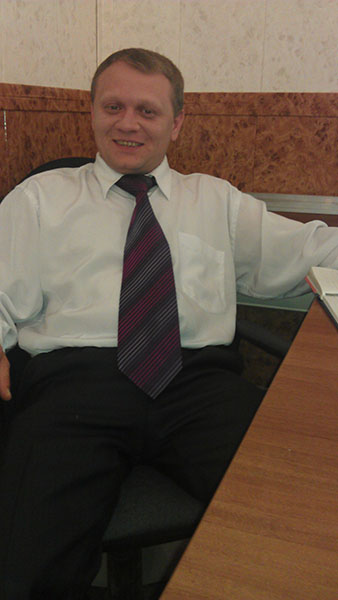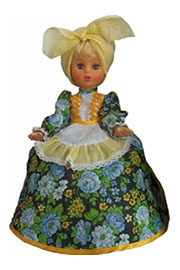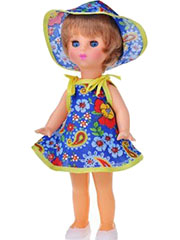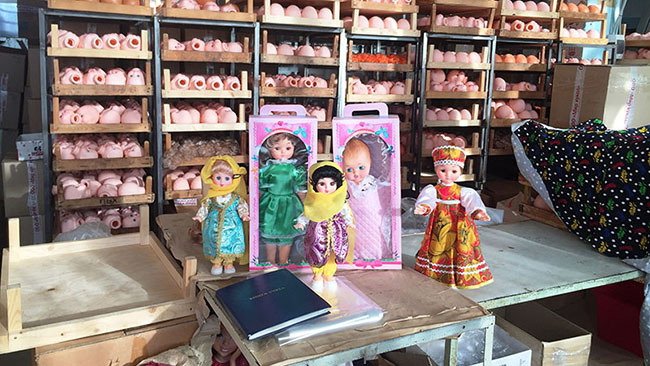Dmitri Kotov: Ivanovo Toy Factory is famous for commitment to traditions

Mir Kukol (World of Dolls) OOO, former Ivanovo Toy Factory is a Russian manufacturer of dolls with more than 70 years of history. Today, the factory is going through its second birth and is looking for new images for dolls keeping commitment to the old traditions. Dmitri Kotov, Director of Ivanovo Toy Factory tells about work at the historical factory and about today’s targets and tasks of the enterprise.
“Your factory is one of the oldest in our country. How do you preserve the history and traditions?”
“There remained only five factories like ours in the post-Soviet territory. Ivanovo Toy Factory was founded back in 1940. Our enterprise was founded on the basis of the former Ivanovo Toy Factory; in the first years it was a small co-operative craft society which produced toys of wood and paper-mache, of the mass of paper and wood-shredding materials. Simply said, paper and wood shredding were the materials for production. The pressed wood-shredded pulp with hide glue was put in metal press-molds and was baked under certain temperatures. In the end, unique Ivanovo dolls were produced. This technology became completely outdated in the end of 1980s, and the factory mastered the production of plastic products. In hard 1990s the factory, like all other manufacturers in the post-Soviet period, was thrown into disorder. The factory started production of plastic canisters which were in high demand at those times; but in the middle of 2000s the factory found a new lease of life and it returned to the main production. We changed the name of the enterprise; we took the name Mir Kukol (World of Dolls). Many employees have been working for thirty or forty years at our factory; they know its history well, and the main thing – they like what they do very much. It helps us preserve our traditions; Ivanovo factory has been producing and keeps producing classic products. Many generations of the Soviet children remember colorful, smiling, charming, a bit naiive faces of the dolls; the Soviet painters were good at toys for children. Of course, we keep on moving forward; the design and technologies are going ahead, although the image of the doll remains unchanged: it is kind and a little bit naiive.”
“What is the product range of the factory today? Are you going to widen you product categories?”
“Today the factory produces a whole variety of dolls: there are more than 100 kinds in different clothes, of different sizes from 30 to 45 cm. These are dolls well known to several generations: Lada, The Gipsy Girl, Cinderella, The Russian Girl; and also new images of dolls in seasonal clothing (winter, spring, summer, autumn), in uniforms and national costumes, and naked dolls with a set of clothes.
“Having a strong commitment to tradition, we are creative, and we introduce innovations. At present we use a larger variety of fabrics, fashion pattern dies similar to those used in modern clothes for children. We produce clothes for dolls: additional wardrobe which is popular among children.
“A year ago we started production of talking dolls. The talking chip is not new to the market; it was used even in the Soviet times. However today the sound producing technologies became much more advanced and we have to follow the trend, so our Ivanovo dolls also started talking. The words are various: we have teaching dolls, singing dolls, laughing dolls; we tend to make the speech recorded on those chips to make them not only interesting, but also useful for children.
“Alisa doll is one of the most popular models; it was designed in cooperation with teachers of one of the kindergartens of Ivanovo in order to teach to get dressed or to dress someone else. Buttons, Velcro fasteners, zippers and laces are used in the clothes of this doll.
 “Every doll passes through the hands of seven specialists before it is ready for a child. The birth of the dolls happens in the factory workshop which makes plastisol heads and bodies of the dolls; after that they are oven baked like bread and after that they are dried and cooled down. The next stage is production of smaller details: hands and legs are made using the method of extrusion blowing. We use raw materials only of Russian origin for these operations.
“Every doll passes through the hands of seven specialists before it is ready for a child. The birth of the dolls happens in the factory workshop which makes plastisol heads and bodies of the dolls; after that they are oven baked like bread and after that they are dried and cooled down. The next stage is production of smaller details: hands and legs are made using the method of extrusion blowing. We use raw materials only of Russian origin for these operations.
“One of the most complicated and touching workshops is the one where the painters work. I am happy to work with people like our painters; many of them have been working here for more than 45 years! The eyes, the eyebrows, the lips are hand-painted … this is a very delicate work, and this is a feature that makes Ivanovo dolls different from all the others: hand painted eyes. Of course, we follow the modern technologies. Today, we also use “living” eyes with eye-lashes which can blink. By the way, do you know that it consists of six details? And all the details we produce here, at our factory.
“The next operation is hair-wig zone for dolls. Just in one second a naked bar becomes a charming girl or a boy with thick hair. Hair is one of a small number of imported goods; we purchase it from Italy.
 “Meanwhile, the work in the sewing workshop goes on. Here the image of dolls is born; the drawings of the dresses are made. Every doll has its own style which is thought through down to smallest details, be it a Yakut or a Gipsy national costume. All the details such as accessories or adornments are invented by designers. Here the fashion pattern dies are made; and here we control the quality of the sewed items; we check if the threads are strong enough, if the stitches are reliable. Mainly we use fabrics of the Russian origin, first of all from Ivanovo. It is our fundamental point: we tend to work using only Russian raw materials, and we support Russian manufacturers.”
“Meanwhile, the work in the sewing workshop goes on. Here the image of dolls is born; the drawings of the dresses are made. Every doll has its own style which is thought through down to smallest details, be it a Yakut or a Gipsy national costume. All the details such as accessories or adornments are invented by designers. Here the fashion pattern dies are made; and here we control the quality of the sewed items; we check if the threads are strong enough, if the stitches are reliable. Mainly we use fabrics of the Russian origin, first of all from Ivanovo. It is our fundamental point: we tend to work using only Russian raw materials, and we support Russian manufacturers.”
“What changes have been made recently? Does the city administration support you?”
“Yes, fortunately, the city administration actively supports our factory and creates new working places. Today, more than 50 employees work at our enterprise including handicapped people and women who are on maternity leave. However, we, of course, wish our federal authorities were paying more attention to the Russian manufacturers. We are actively looking for various ways to keep our manufacturing running and to enter a wider market. My task, as the director, is to provide a non-stop production process and to establish stable sales. We’d like to preserve our classic products, the habitual kind and fair image of the Soviet dolls for our children and grandchildren to love these dolls, too.
“What are our plans? We plan to produce Russian toys! Not only dolls, but other categories of toys. We’ll produce toys for bathing, the ducks which children love; we’ll make them of plastisol. We are working on designing production of toy cars and toy service automobiles, toy soldiers for boys. Our equipment and skills of our staff allow us to make it. We are always searching for new ideas. The secret of our success is that whatever the employees of our company do, they do it wholeheartedly; and our products is the evidence of this.”


